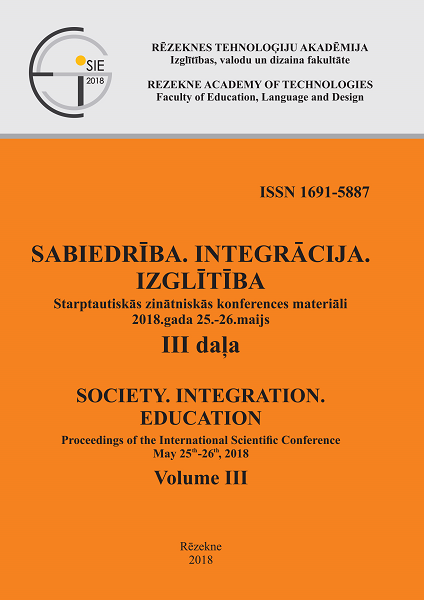QUALITY OF INCLUSIVE EDUCATION, OBSTACLES AND NECESSARY PEDAGOGICAL SOLUTIONS IN WORKING WITH PUPILS WITH AUTISM IN ITALY
DOI:
https://doi.org/10.17770/sie2018vol1.3344Keywords:
classmates resource, obstacles, organization, planning, pupils with autism special needs, quality of inclusive education, school, solutions, special didacticsAbstract
Nowadays are increasingly encountered children diagnosed with autism, but there are still serious problems of inclusion of these children in the comprehensive general education system. This is due to various factors. The author of this study many years is working in the schools of special education in Rome, so in the year 2010 started research on inclusion of pupils with autism into the Italian schools. The idea is to transmit the author's knowledge and experience further in Latvia, where inclusion of such pupils into general education schools is still at an early stage because of a lack of both human resources and financial resources, as well in regard of experience and clear understanding about organization and management of this inclusion process. Here in this article is described the purpose of the study to explore the experience of people linked with the special pedagogy in Italy, attitudes, thoughts on the inclusion process quality of pupils with autism in schools, obstacles and solutions needed by methodological instructions. It will complement the already existing knowledge and give the opportunity to learn from the gained experience.The study is built on research activities and there are used both theoretical and empirical methods, such as scientific literature research, analysis and interview with 4 individuals who are in close contact with the pupils with autism. The qualitative data resulting from interview are processed with the software AQUAD Six. The results obtained from the interview indicate that there are serious difficulties of inclusion of the pupil x with autism in the school because the teachers and support staff are not professionally prepared for it.
Downloads
References
Cottini, L. (2009). Il bambino con autismo in classe. Quattro parole chiave per l’integrazione. Firenze, Italia: Giunti.
Farci, G. (2005). Per un’educazione speciale dell’alunno con disturbi pervasivi dello sviluppo. Autismo e disturbi dello sviluppo, 3 (1), 9-22.
Fombonne, E. (2009). Epidemiology of pervasive developmental disorders. Pediatric Research, vol. 65, n. 6, (pp. 591-598).
Frith, U. (1989). Autism. Explaining the Enigma. Oxford, England: Blackwell.
Rutter, M. (2005). Aetiology of autism: findings and questions. Journal of Intellectual Disability Research, 49(4), 231–238. doi: 10.1111/j.1365-2788.2005.00676.x
SINPIA, Società Italiana di Neuropsichiatria dell’Infanzia e dell’Adolescenza. (2011). Linee guida per l’autismo. Diagnosi e interventi. Trento, Italia: Erickson.
Venuti, P. (2012). Intervento e riabilitazione nei disturbi dello spettro autistico. Roma, Italia: Carocci.
Vivanet, G. (2015). Un’ analisi evidence - based sull’efficacia di metodi e tecnologie didattiche per l’autismo. In R. Vianello, S. Di Nuovo, (a cura di), Quale scuola inclusiva in Italia? (pp. 209 – 222). Trento, Italia: Erickson.


